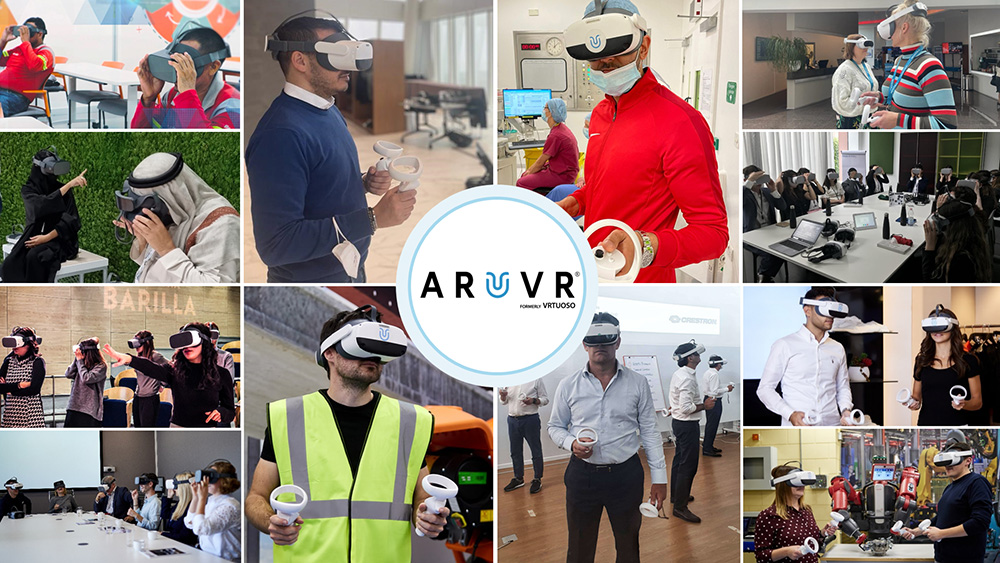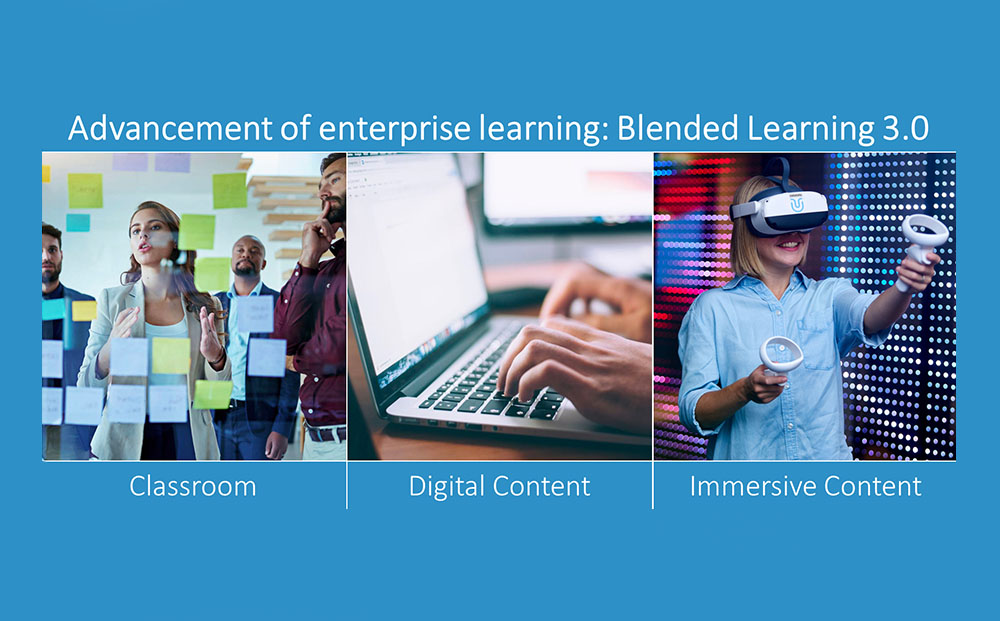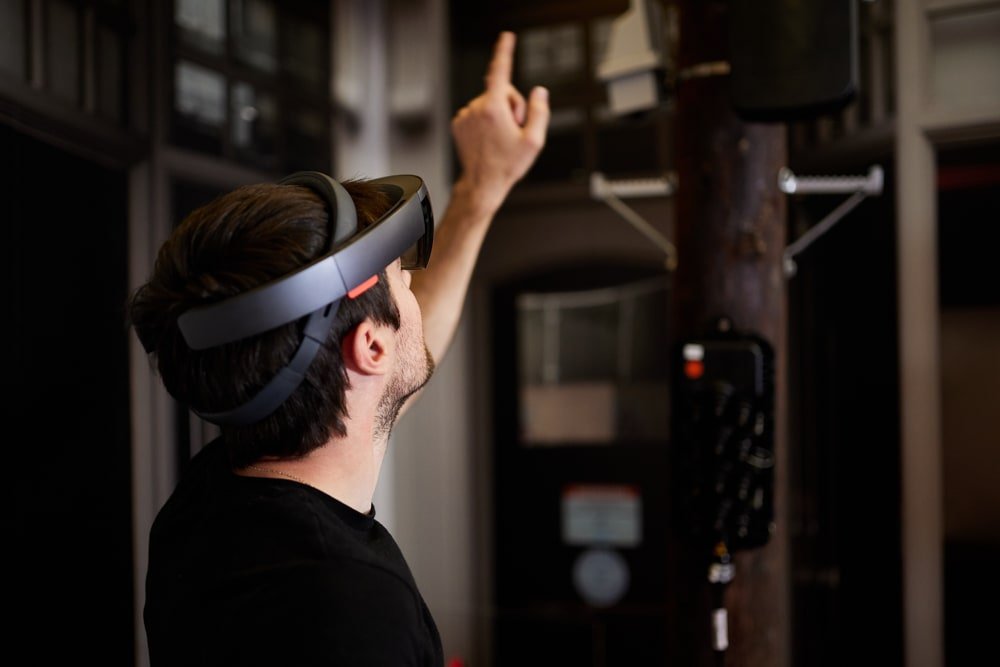What is Immersive Training? Blended Learning 3.0
The Basics of Immersive Learning and Why It Works
1 December 2022
Learning as a concept has come a long way over the decades. We’ve shifted from relying almost exclusively on books and in-person teaching to leveraging digital tools like computers and the internet to make learning more scalable, inclusive, and rich.
As technology continues to evolve, our opportunities for bringing educational experiences to learners are also transforming. In particular, the XR (Extended Reality) world offers training companies and educators a unique opportunity to embed their students in powerful, experience-driven lessons. This is the era of “Immersive Training”.
Considered to be the next level of experiential learning, immersive learning builds on the best practices of helping students to learn “by doing”, through interactive environments.
Here’s your guide to Immersive Training.
What is Immersive Training?
Immersive Training, or Immersive Learning, is an experiential training methodology that takes advantage of the unique features of “extended reality”. This allows for the simulation or for the enhancement of real-world scenarios and experiences, capable of training employees in an engaging, effective, safe atmosphere.
HR and L&D leaders are challenged to find new ways to recruit, engage, upskill and retain an increasingly distributed workforce. The current traditional training (Blended Learning 2.0) is not effective anymore. Tradition classroom training is theory focused, easy to forget, hard to put into practice, and no data and is captured from student. E-learning training instead is not engaging, mostly passive, learn by watching, and only limited data.

Accenture stated that research proves that learners forget 70% of training content within 24 hours and nearly 90% in a month.
Immersive training builds on the practical concept of learning, allowing learners to transform from passive spectators into active participants in a learning environment. The approach is based on decades of neuroscience, which indicate performance in a virtual work environment can significantly influence performance in a real-world space.
According to PWC, using immersive learning to embed employees into “real” work situations can lead to several positive outcomes. For instance, VR learners are 40% more confident than their peers, 35% more capable of acting on what they learn, and 3.75 times more emotionally connected to the content they consume. Students can also complete immersive training sessions up to four times faster than classroom courses for half the price.
Immersive Content, together with Classroom and Digital Content, is forming a very powerful training framework: Blended Learning 3.0.
The Technologies Used for Immersive Training
Immersive training requires a combination of advanced learning theory and innovative technology. Though immersive learning is often regarded, the two processes aren’t entirely the same. Experiential learning doesn’t require technology, as it often places the student directly in the environment where they need to develop their knowledge. Immersive learning uses critical technology to create a safer, more dynamic educational environment.

Some of the core technologies used in immersive training include:
Virtual Reality:
VR hardware and software allow companies to immerse their learners in unique digital worlds, often designed to replicate or simulate a specific environment. Using a VR headset, students can interact with this environment safely, learning how to perform different skills without putting themselves at risk.
Augmented Reality:
Instead of blocking the real world entirely, augmented reality blends the physical world with digital content. This can allow the placement of valuable assets and annotations in a real-world environment to expand a user’s knowledge. AR solutions can be accessed through smart glasses, headsets, or smartphones.
Mixed Reality:
Mixed reality combines various augmented and virtual reality elements to allow for a unique learning experience. The solution enables students to interact with digital content as though it existed in the real world without overlooking their physical surroundings. MR also paves the way for holo-presence and teleportation in the XR space.
360-degree content:
360-degree live videos and content are designed to bring immersive learning into environments where users can’t access XR headsets and wearables. The user can step into the filmmaker’s point of view and explore environments using an app on a smartphone or a specific program on a computer.
The Benefits Of Immersive Training
Immersive training allows students to experience scenarios where they may need to use specific skills. This allows for the development of knowledge, as well as muscle memory. In an age filled with distractions, immersive learning will enable companies to engage their students more effectively and keep them focused on the task.

“Extended Reality Learning is not replacing classroom or e-leaning, instead it adds a very important and strong new layer into the training-mix which allows companies and institutions to gain ROI and learners’ Benefits which were never possible before. As well as exposes instructors and companies to a new dimension and rich data from learners which provides tremendous insights and proof points for knowledge acquisition. “Immersive Learning is the ultimate evolution of training – blended learning 3.0, it provides users with proven pedagogical benefits and strong ROIs and help equip today’s workforce with the skills and knowledge they need to perform in today’s fragile economy.”
In fact, according to PWC’s study mentioned above, VR learners are up to 4 times more focused during training sessions than people using e-learning technology. Some of the most significant benefits of immersive training include the following:
Better focus:
As mentioned above, immersive training helps remove the outside world’s distractions. In VR, you’re placed in an entirely new environment where you’re less likely to be distracted by your smartphone or the sound of traffic. In AR and MR, you’re actively interacting with gamified, entertaining experiences that consume your full attention and keep you focused on learning.
Emotional connections:
As mentioned above, XR solutions can help learners to feel more emotionally connected to the content they’re consuming. Because the experience feels highly realistic and engaging, we’re more likely to feel connected to the things we’re doing. Being emotionally connected to what we learn also means we’re more likely to retain the information we collect during training.
Better knowledge retention:
Immersive training allows people to practice the skills they’re learning in a realistic environment. They’re not just watching someone else do a process; they’re doing it themselves. This builds muscle memory and improves the students’ chances of remembering whatever they’ve been exposed to. As PWC found, immersive learners are more confident in putting what they learn into action.
Increased engagement:
Keeping employees and students engaged during a training experience can be difficult, particularly when it comes to either dry and “boring” topics or flat and “wordy” PowerPoint slides. However, Immersive training helps to make the experience more fun and motivating. Many of the tools available for immersive training come with gamification elements that reward people every time they complete a task.
Personalization:
Thanks to training platforms like ARuVR, companies can build their own custom learning environments from scratch based on real-world environments and scenarios their employees might encounter. This allows to put learners at the center of the topic, he/she is the main actor so feel genuinely connected and have a more personalized and realistic learning experience.
Immersive Training is the Future
Companies and innovators are constantly searching for new ways to make training more engaging and powerful for their team members. With the ability to engage, motivate, and inspire students like never before, immersive training could be the answer businesses have been searching for.
Immersive training could be the tool that powers a future of more engaged, knowledgeable, and invested learners.
—
This article first appeared in XR Today, 28th November 2022
